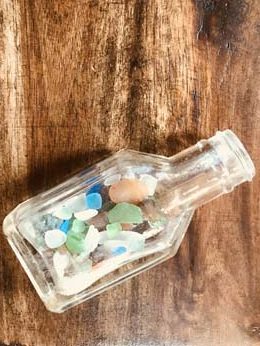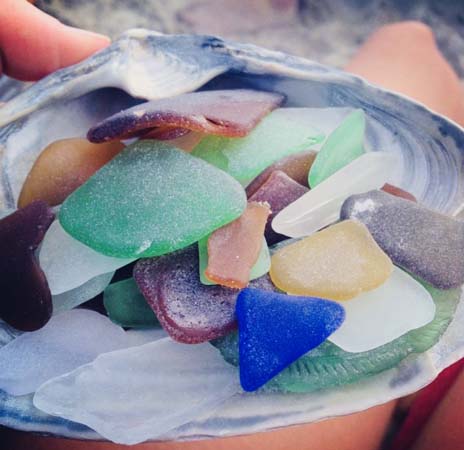Jewels of the Sand
The storm has passed. The beach, still slightly damp from where the waves ran up to the dune line is littered with the detritus of the ocean—shells of every description, pieces of driftwood and the real treasure, small pieces of glass, scoured by salt and sea.
Beginning its life as a jar or bottle, years after being tossed into the sea the shattered remains come back as fascinating links to the past.
Most sea glass, of course is fairly recent—although that’s a relative term. It takes a minimum off 7-10 years immersed in the sea for the sharp edges and translucent character of glass to be transformed. Most sea glass is probably 30 to 40 years old, and occasionally some very rare pieces of glass are found that are 100 years old or more.
The colors of sea glass reflects the colors of glass that society is producing at any time.
For some time the most common colors of glass have been amber or brown, white or clear, and green. Those are also the most common sea glass colors.

There are different shades of al the colors, and number of reasons why that occurs. The original color is a huge part of that, but also the length of time in the water and environmental conditions.
Historically different periods of time favored certain colors of glass. We don’t see very much black glass in the 21st century but before 1890, beer, ale, bitters and whiskey bottles commonly used black glass.
Finding black glass on the beach would be the equivalent of stumbling on a diamond in the middle of a field of stones. It can also be easily mistaken for a rock, since it has been buffeted and shaped by the ocean for 125 years or more.
During the Great Depression, pastel colored glass was commonly used for promotions, especially pink for sugar bowls or decorative glasses. The Depression is considered a likely source for much of the pink sea glass, although there are more modern sources.
What are the Uses
You have walked the beach for the past three days and have managed to accumulate 20 or 30 pieces of sea glass. The question becomes, “What should we do with it?”
A lot of people simply collect it, fascinated by its colors, shape and history.
One of the largest sea glass collections in the world is on the Outer Banks at the Beachcomber’s Museum in Nags Head.
Here’s what Richard LaMotte, widely seen as the reigning expert on sea glass said in his book The Lure of Sea Glass, says about the Beachcomber Museum:
“Inside a weary 1920s bungalow patiently sits the most extraordinary and diverse collection of seaside relics ever amassed by a beachcomber.” Richard LaMotte’s 2015 book, “The Lure of Sea Glass”.
Another option is sea glass jewelry, which is very popular.
Like almost anything that is used to make jewelry, sea glass has various grades of quality, the highest being jewelry grade—and even that is graded.
Jewelry grade sea glass is well-rounded and completely frosted from the action of the sea. There should also be no chips in the glass.
Most sea glass is considered craft grade; it may have some chips in it or has not become completely smooth or opaque yet. Not quite as rare, nor as expensive as jewelry grade, but jewelry can be made from it.

Where and When to Find It
The best time for sea glass hunting is at low tide. The ribbon of shells is the most likely hiding spot for sea glass. Even better, try low tide after a storm has passed.
Sea glass is becoming harder to find. Plastics have taken over much of the bottling industry and recycling has further reduced the amount to glass in the sea. And a better awareness of the impact littering has on the environment can’t be discounted.
Nonetheless, there is still beach glass to be found on the beaches of the Outer Banks—perhaps not as plentiful as it once was, but it’s still there, waiting to be found.
